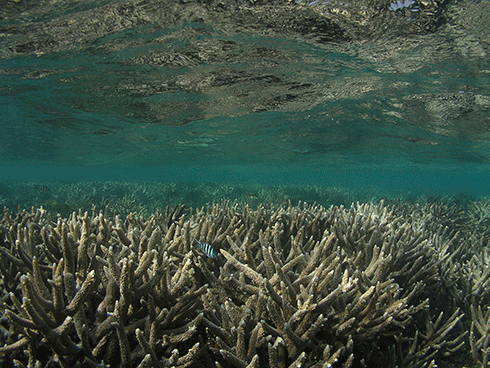
|
Published: 9 July 2014
Pilbara lessons indicate Great Barrier Reef in danger from ‘perfect storm’
Scientists at a recent coral reef symposium in Canberra highlighted the degradation of reefs along the north-west Australian coast as an indicator of what lies ahead for the Great Barrier Reef when certain conditions combine to create a ‘perfect storm’.
‘Reefs north of Exmouth (Pilbara, WA) have experienced large-scale bleaching in the past five years,’ notes Professor Malcolm McCulloch from the ARC Centre of Excellence for Coral Reef Studies (Coral CoE), University of Western Australia.
Prof McCulloch is investigating the Pilbara bleaching event, and has found that the bleaching was widespread, occurring both inshore and offshore. The main bleaching was across dredged sites around Barrow and Onslow islands as well as the now near-pristine Montebellos – an area abandoned by humans since atomic bomb testing took place at the site mid-last century.
‘The Pilbara reefs experienced bleaching due to higher temperatures that extended way beyond the dredging areas,’ he says, adding that the La Niña climate event of the past five years has been the main contributor to intense and prolonged warming along the west coast.
Prof McCulloch warns of the imminent El Niño – the opposite phase of La Niña – as it will cause intense warming down the east coast of Australia, including the Great Barrier Reef. The World Meteorological Organization has just released a report indicating El Niño is likely to occur as early as spring this year.
The combined effects of El Niño, anthropogenic climate change and a possible increase in coastal development will create the conditions for bleaching events, says Prof McCulloch.
‘Climate change pays no attention to whether an area is pristine or polluted. And when dredging and climate change interact, there are quite serous effects that don’t happen separately, they happen together.’
McCulloch says the dredging undertaken at Barrow, part of the massive $54 billion Gorgon natural gas project, was one of the biggest dredging projects of its kind in the world.
‘With the scale of project similar to what’s proposed for the Great Barrier Reef and Abbot Point, what we can take away from this experience in Western Australia is a likely indication of the effects that lie ahead for the Great Barrier Reef.’
‘With the Great Barrier Reef now about to get warmer, what we do hope is that at the very least, dredging in this area be delayed until the cooler phase of La Nina returns to the east coast.’
Source: ARC Centre of Excellence Coral Reef Studies




